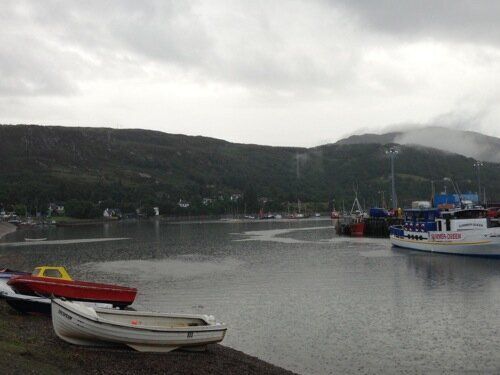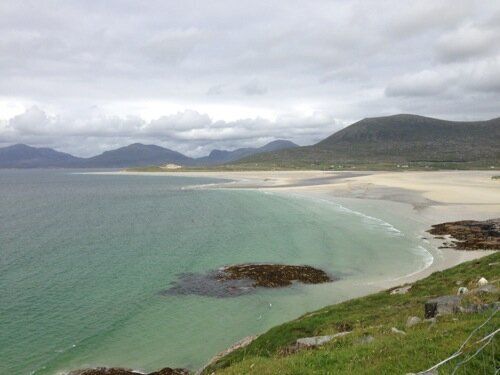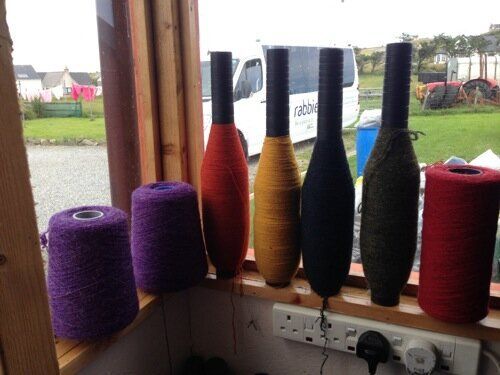It's 9am on a Monday morning when my journey begins. Standing on Edinburgh's Royal Mile, the ghosts of last night's festival antics still playing out along the streets, I jump on board a minibus and began my ascent northwards. I'm looking for a taste of history, authenticity and the real Scottish character from this week - surely that's not too much to ask?
The historic village of Dunkeld is the first stop, and a short walk takes me into the forest and to some stunning waterfalls. The route continues northwards through the Grampian Mountains to the Spey Valley until we reach the infamous Loch Ness. No sightings of dear Nessie on this windy summer's day, but the infamous Loch is vast and otherworldly - understandably, the kind of place that serves as the birthplace of mythology.

Credit: Lauren Razavi
Ullapool, where I'll be staying the night, is a step back in time. The small harbour town has clung to its traditions, making it easy to imagine life here generations ago. The Scots I meet here are laid back and realistic; hard grafters in the national tradition, and unfazed by the release of the latest iPhone or how many square feet your apartment is. It might be mid-August, but the next morning I wake to the sound of rain. The seasons seem to lose their identity at some point north of the border. I trudge in a rain poncho down to the ferryboat. I might be damp, but there's something very authentic about this Scottish episode.
The two-hour sail along Loch Broom offers up wildlife in the vein of that seen in the recent BBC series exploring the Outer Hebrides. Dolphins, whales and seabirds glance upwards at me nonchalantly as I stare up and down at them. Nature and landscape are truly unspoiled here; it's a kind of beauty that's become strangely foreign to a city girl like myself.

Credit: Lauren Razavi
The afternoon takes me north on the Isle of Lewis to Arnol through a variety of traditional crofting townships, and provides the opportunity to explore historic old "blackhouses". The island's most renowned blackhouse, known as No. 42 Arnol, is a fascinating piece of living Scottish history. The thatched house was built around 1880 and was inhabited by a Hebridean crafting family and their animals until 1966. It remains fully furnished, complete with an attached barn, byre and stackyard, and a smoky peat fire still burns in the open hearth.
Other impressive offerings on Lewis include gorgeous white-sand beaches across the coastline, mysterious ancient stone circles in Callanish, and dramatic, rugged hills all around. Stornoway, the capital of the Outer Hebrides and the main town on Lewis, is a pleasant town; perfect for a stroll and offering outstanding restaurants (more about that in my next post). The most northerly tip of the island, known as the Butt of Lewis, has an excellent lighthouse. From the vantage point of this grand structure, there's no land between you and the Americas.

Credit: Lauren Razavi
The following day, I venture southwards to arrive on the Isle of Harris, home to the highest mountains in the Outer Hebrides and the stunning white sands and blue-green waters of Luskentyre. This enchanting feat of Scottish nature has been voted Britain's premier beach and, impressively, named one of the top ten beaches in the world.
The island is best known, however, for its locally produced cloth - Harris Tweed. I am privileged to visit a local weaver, an aged man with a dry sense of humour, who reveals something of the cloth's history and how it is made. As he demonstrates, the traditional weaving methods, which have remained the same for hundreds of years, are incredibly intricate and time-consuming. A metre of tweed can take more than half an hour to produce on a traditional loom, and since these machines are no longer manufactured, it can be extremely troublesome if a loom breaks down.

Credit: Lauren Razavi
As a cottage industry, weaving tweed has always involved producing articles made entirely by hand. Historically, locals spent long winter evenings weaving garments from their own wool as a productive pastime. Harris Tweed became known as a cloth of quality and distinction, and by the end of the 19th century, it began to appear in the national British marketplace, before quickly reaching the European continent and then spreading as far as Japan. Today it is known globally and used on catwalks throughout the world at all the big international fashion events.
Another ferry ride takes me to the Isle of Skye, the final island of my whirlwind tour of Scottish beauty. I begin with a trip to the Quiraing mountain pass which offers a spectacular walk through some of Skye's extraordinary geological scenery. The landscape provides different routes for those looking to enjoy a leisurely wander, and those looking to push themselves with a more challenging hike.

Credit: Lauren Razavi
The rest of the day is taken up with visits to the Kilt Rock, another fascinating geological site, and to the oldest continuously inhabited castle in Scotland, Dunvegan. The Kilt Rock is composed of basalt columns which look like the pleats in a kilt, and boasts a breathtaking waterfall cascading over the cliffs and down into the sea below. Meanwhile, Dunvegan Castle is known for being the ancestral seat of the Clan MacLeod, an ancient Scottish clan that is closely associated with the Isle of Skye and its often conflict-ridden history.
The final day of my journey comes too quickly, and it's time to journey back down south towards Edinburgh. There's plenty to see on the way though: the Cuillin Mountains, the Eilean Donan Castle and the Falls of Dochart in Killin to name a few. Yet more stunning scenery and thought-provoking history is on offer as we venture through the Highlands, purposely taking a different route to ensure there are ample opportunities for exploration even on the last day. The dramatic scenery and the dark history of Glencoe and a lunch stop at Fort William are particular highlights.
A visit to Scotland offers everything you could want from a short break: gorgeous beaches, towering castles, ancient ruins, and a plethora of awe-striking natural sights covering mountains, skies and water. I got my taste of history, authenticity and the real Scottish character, with the added bonus of a time to reflect and relax in the most serene of locations. Needless to say, a trip to the Scottish Highlands and Islands comes recommended from me.
PLAN YOUR TRIP
For more information about the Scottish Highlands and Islands, go to Visit Scotland who are celebrating their Year of Natural Scotland in 2013.
To explore the Highlands and Islands with Rabbie's Tours as I did, begin by visiting their website. My chosen adventure was the Outer Hebrides and Skye 6-day tour.
If you need help with deciding where to eat and sleep during your travels in Scotland, have a look at my guide to accommodation and restaurants across the Highlands and Islands by clicking here.
More about my recent visit to Scotland can be found on my blog Take on the Road. Soon, tips and advice for living and working in the Highlands and/or on the Islands will be available on my new website Live and Teach.
